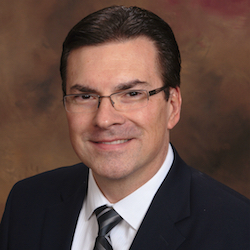
Working with several clients in California, I have the opportunity to provide consultative services, including mock surveys and training, to several senior living and long-term care providers around the state. Although it’s no secret that the past year has been particularly challenging for all types of senior living and healthcare providers in California and beyond, the response to disasters (yes, disasters — plural) by one particular skilled nursing facility in Shadow Hills represents the pinnacle of preparedness, dedication and resiliency.
For any homeowner or business operator nestled in the hills in Los Angeles County near Burbank, CA, the threat of wildfire is ever present. In September, a raging wildfire in La Tuna Canyon to the east of Shadow Hills Convalescent Hospital was this facility’s first real brush with disaster in 38 years. As the fire grew in intensity and acreage at an alarming rate, SHCH was put on high alert and prepared to evacuate.
The exterior sprinkler system manually was turned on to drench the vegetation behind the building, and fire crews initiated a massive attack to stop the inferno from knocking on the facilities back door. An exterior sprinkler system had been installed electively by the facility’s owner to provide an extra layer of protection to the property during vegetation and wildfires.
As the fire raged, residents were evacuated from the upper level of the building, which actually is positioned on the side of a hill to the lower level near the street. Facility staff worked tirelessly in concert with fire department and EMS resources as they prepared to initiate total evacuation. Firefighting efforts were successful, and the blaze was stopped within a hundred yards of so from back of the property.
Although exhausted and emotionally drained, the team members at SHCH implemented all elements of their emergency plan and immediately went into the recovery mode to get back to business as usual in the shortest time possible. Residents were engaged in a variety of social activities during the incident and were provided with extra culinary treats to keep their minds off the emergency situation from beginning to end.
Shadow Hills Convalescent Hospital is a small, 67-bed facility operated by a local family that also owns and operates another facility in Arcadia. Leadership, including the facility’s owner / administrator, has been hyper-focused on disaster since the major earthquake and tsunami devastated Japan in 2011.
Beyond new Centers for Medicare & Medicaid Services emergency preparedness requirements that started to be enforced Nov. 15, the owners and facility leadership voluntarily brought preparedness to the next level by purchasing caches of emergency equipment, supplies and provisions for each location to help ensure the safety of residents and staff. One major acquisition included the purchase of a large portable generator, housed on its own trailer, that can be deployed to either facility during an emergency.
In December, just as things were stating to get back to normal after the massive La Tuna Canyon fire, smoke was seen in the distance in the opposite direction of the facility. Once again, SHCH had to activate its emergency operations plan and establish “unified” incident command with local fire and EMS resources.
Fortunately, the December fire approaching from the opposite direction of the September fire did not make it as close to the facility, but houses and other structures could be seen burning on the hills directly across the street. According to fire officials, the property was located in a good position of defensibility, and although evacuation was a serious option that facility staff members were prepared to initiate, it ultimately was not needed.
Fast forward to early January. The hills in this part of Los Angeles County, as well as all of the other burn areas around the state, were scorched and barren. The smell of smoke lingered in the air when a major rain storm started to flood the countryside. As the drenching rain pounded the damaged earth, sections of the landscape started to slurry away, burying buildings and roadways as well as anything else in its path.
Once again, SHCH was put on high alert and prepared to evacuate. Anxiety was high, but confidence was even higher. This facility had experienced two major emergencies in less than three months and knew the drill. Staff members followed the emergency operations plan and kept their focus on the safety of residents and staff.
SHCH was prepared to evacuate but got the good news that all were to shelter-in-place during this unfolding disaster. Sadly, more than a dozen people were killed in California in the days that followed. SHCH once again was put to the test and passed.
After interviewing the administrator, the Disaster Services Division and other team members, I was amazed to find out that during all three disasters that this tiny-yet-mighty long-term care facility faced in a very short amount of time, not a single employee abandoned the skilled nursing facility during times of crisis. The DSD proudly reported that all staff members went above and beyond by remaining dedicated to their residents throughout each unpredictable incident. Even as some staffers couldn’t verify whether their own homes were burned or damaged by either of the two unforgiving fires and subsequent mudslides, all employees stayed with the residents and did their jobs.
Although undoubtedly there are hundreds of stories such as this one that haven’t been told out of the Florida, Texas and other places where disasters recently have occurred, the story of Shadow Hills Convalescent Hospital must be told. Its intimate experiences with three fast-moving disasters illustrate the commitment that facility ownership, leadership and staff have to the senior living community.
Whether or not your facility is affected by the new CMS rules of participation on emergency preparedness, you must be ready for disaster.
Stan Szpytek is the president of consulting firm Fire and Life Safety in Mesa, AZ, and is the life safety / disaster planning consultant for the Arizona Health Care Association and California Association of Health Facilities. He is a former deputy fire chief and fire marshal and has more than 40 years of experience in life safety compliance and emergency preparedness. He recently shared fire safety tips with McKnight’s Senior Living. E-mail Szpytek at [email protected].
McKnight’s Senior Living welcomes guest columns on subjects of value to the industry. Please see our submission guidelines for more information.




